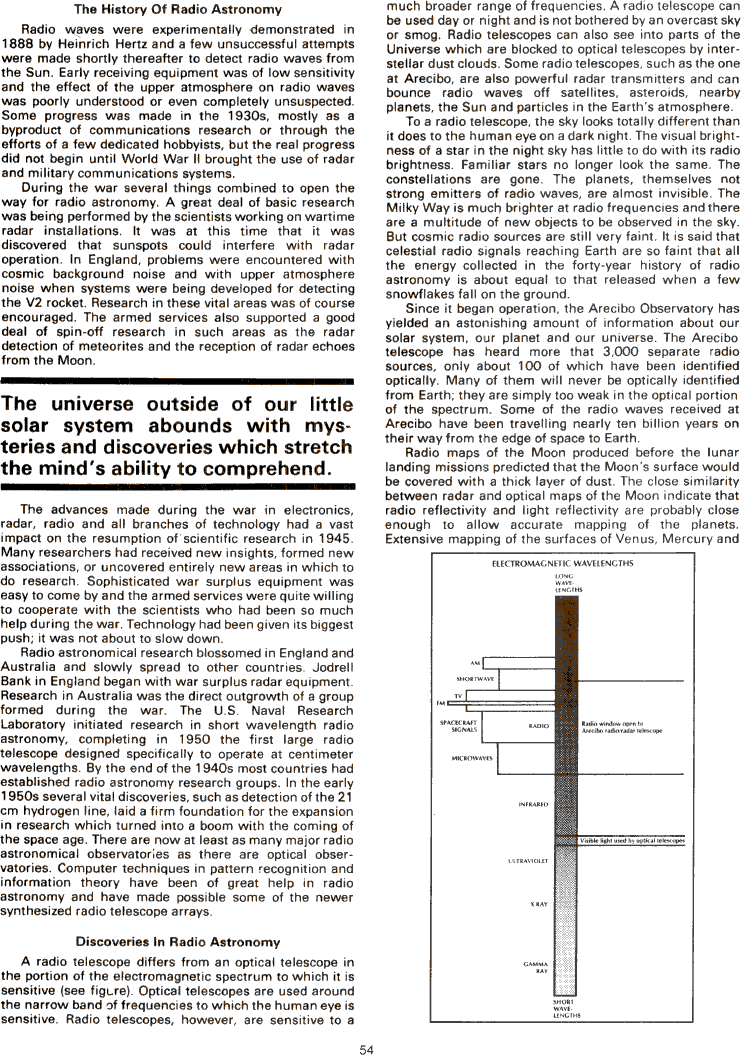The Best of Creative Computing Volume 2 (published 1977)
An Ear On The Universe (History of Radio Astronomy, Discoveries in Radio Astronomy)

The History Of Radio Astronomy
Radio waves were experimentally demonstrated in
1888 by Heinrich Hertz and a few unsuccessful attempts
were made shortly thereafter to detect radio waves from
the Sun. Early receiving equipment was of low sensitivity
and the effect of the upper atmosphere on radio waves
was poorly understood or even completely unsuspected.
Some progress was made in the 1930s, mostly as a
byproduct of communications research or through the
efforts of a few dedicated hobbyists, but the real progress
did not begin until World War ll brought the use of radar
and military communications systems.
During the war several things combined to open the
way for radio astronomy. A great deal of basic research
was being performed by the scientists working on wartime
radar installations. lt was at this time that it was
discovered that sunspots could interfere with radar
operation. In England, problems were encountered with
cosmic background noise and with upper atmosphere
noise when systems were being developed for detecting
the V2 rocket. Research in these vital areas was of course
encouraged. The armed services also supported a good
deal of spin-off research in such areas as the radar
detection of meteorites and the reception of radar echoes
from the Moon.
_________________________________
The universe outside of our little
solar system abounds with mysteries
and discoveries which stretch
the mind's ability to comprehend.
_________________________________
The advances made during the war in electronics,
radar, radio and all branches of technology had a vast
impact on the resumption of scientific research in 1945.
Many researchers had received new insights, formed new
associations, or uncovered entirely new areas in which to
do research. Sophisticated war surplus equipment was
easy to come by and the armed services were quite willing
to cooperate with the scientists who had been so much
help during the war. Technology had been given its biggest
push; it was not about to slow down.
Radio astronomical research blossomed in England and
Australia and slowly spread to other countries. Jodrell
Bank in England began with war surplus radar equipment.
Research in Australia was the direct outgrowth of a group
formed during the war. The U.S. Naval Research
Laboratory initiated research in short wavelength radio
astronomy, completing in 1950 the first large radio
telescope designed specifically to operate at centimeter
wavelengths. By the end of the 1940s most countries had
established radio astronomy research groups. In the early
1950s several vital discoveries, such as detection of the 21
cm hydrogen line, laid a firm foundation for the expansion
in research which turned into a boom with the coming of
the space age. There are now at least as many major radio
astronomical observatories as there are optical observatories.
Computer techniques in pattern recognition and
information theory have been of great help in radio
astronomy and have made possible some of the newer
synthesized radio telescope arrays.
Discoveries In Radio Astronomy
A radio telescope differs from an optical telescope in
the portion of the electromagnetic spectrum to which it is
sensitive (see figure). Optical telescopes are used around
the narrow band of frequencies to which the human eye is
sensitive. Radio telescopes, however, are sensitive to a
much broader range of frequencies. A radio telescope can
be used day or night and is not bothered by an overcast sky
or smog. Radio telescopes can also see into parts of the
Universe which are blocked to optical telescopes by interstellar
dust clouds. Some radio telescopes, such as the one
at Arecibo, are also powerful radar transmitters and can
bounce radio waves off satellites, asteroids, nearby
planets, the Sun and particles in the Earth's atmosphere.
To a radio telescope, the sky looks totally different than
it does to the human eye on a dark night. The visual brightness
of a star in the night sky has little to do with its radio
brightness. Familiar stars no longer look the same. The
constellations are gone. The planets, themselves not
strong emitters of radio waves, are almost invisible. The
Milky Way is much brighter at radio frequencies and there
are a multitude of new objects to be observed in the sky.
But cosmic radio sources are still very faint. It is said that
celestial radio signals reaching Earth are so faint that all
the energy collected in the forty-year history of radio
astronomy is about equal to that released when a few
snowflakes fall on the ground.
Since it began operation, the Arecibo Observatory has
yielded an astonishing amount of information about our
solar system, our planet and our universe. The Arecibo
telescope has heard more that 3,000 separate radio
sources, only about 100 of which have been identified
optically. Many of them will never be optically identified
from Earth; they are simply too weak in the optical portion
of the spectrum. Some of the radio waves received at
Arecibo have been travelling nearly ten billion years on
their way from the edge of space to Earth.
Radio maps of the Moon produced before the lunar
landing missions predicted that the Moon's surface would
be covered with a thick layer of dust. The close similarity
between radar and optical maps of the Moon indicate that
radio reflectivity and light reflectivity are probably close
enough to allow accurate mapping of the planets.
Extensive mapping of the surfaces of Venus, Mercury and
[Image]


